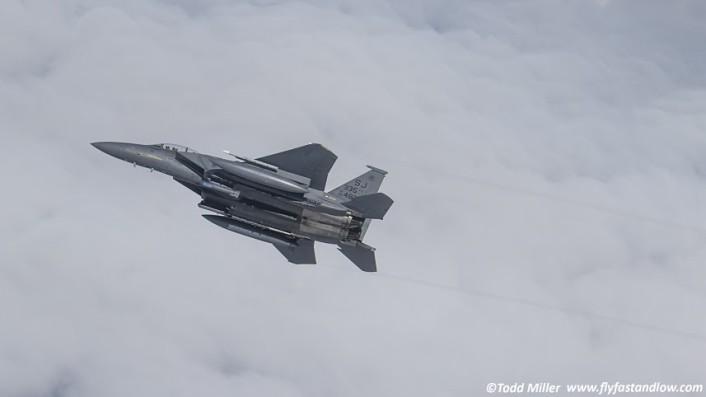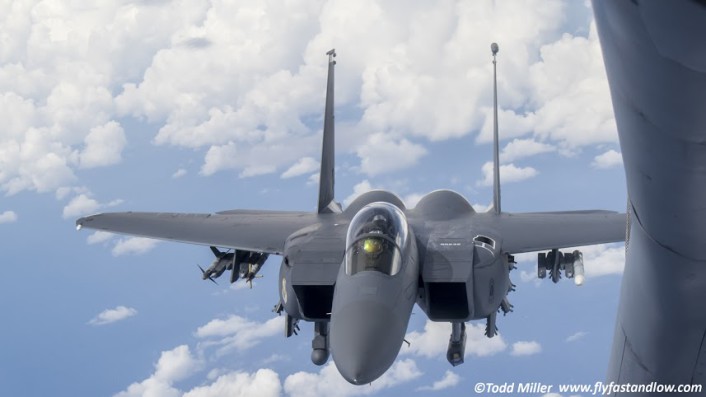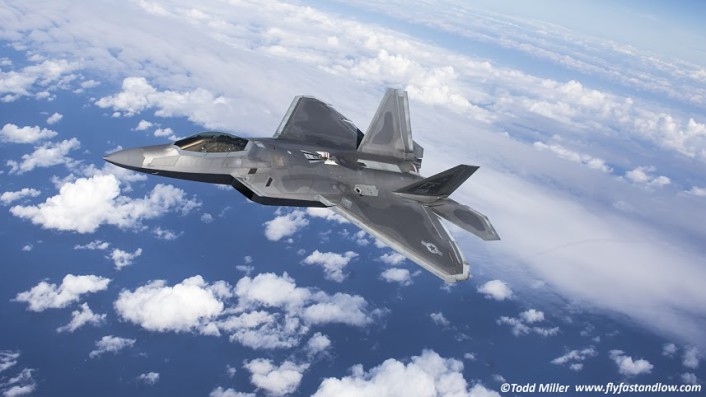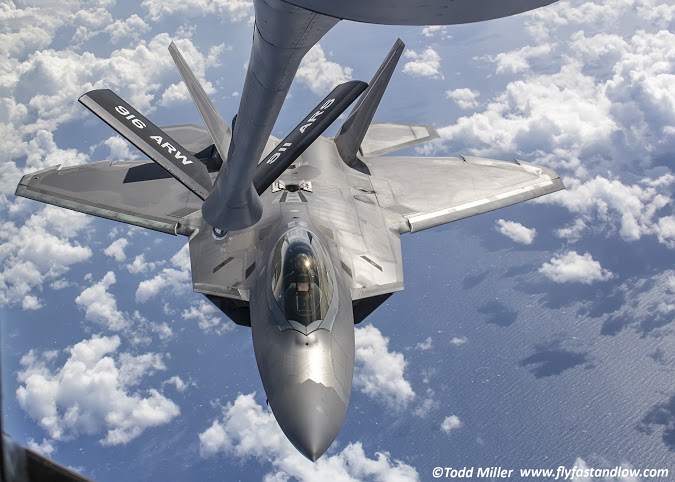The Aviationist visits the 4th FW at Seymour Johnson AFB to report on “Razor Talon,” a monthly large force exercise sponsored by the USAF.
Razor Talon is a monthly aerial warfare exercise that represents a tremendous “win” for the USAF both in terms of cost efficiencies and proficiency gains. The exercise has been primarily designed for three core Wings, the 4th FW F-15E Strike Eagles of Seymour Johnson AFB, the 1st FW F-22A Raptors of Langley AFB and the 20th FW F-16CM Vipers of Shaw AFB. The September Razor Talon also included the T-38C from Langley AFB, the RC-135, E-3 AWACS, and E-8 JSTARS platforms from their associated bases.
Notable historical contributions of the 4th FW 335th FS “Chiefs” include the role they executed as the primary group tasked to search for and destroy Iraq’s module Scud missiles utilized in the Gulf War. As a result of their ultimate success they were nicknamed “SCUD BUSTERS,” though they also made aerial warfare history by downing an Iraqi helicopter in the air using a laser-guided bomb! (USAF Fact Sheet) The F-22A Raptors, the most advanced air superiority fighter in service are becoming much more visible internationally as they are being deployed globally in response to events in a number of theaters. The 20th FW F-16CMs have consistently been involved in critical domestic and global US operations in a variety of roles, though they are primarily known for their expertise in the Wild Weasel mission of SEAD (suppression of enemy air defenses).
“Razor Talon represents a natural progression from unit training towards the broader platform integration that takes place in a campaign”
We were fortunate to get a bird’s eye view of the exercise via a supporting KC-135R tanker from the 916th Air Refueling Wing (ARW) flown by personnel from the 911 Air Refueling Squadron (ARS). During the tanker flight F-22s from the 94th & 27th FS and F-15Es from the 335th FS visited for refueling.

Given the proximity of the participating bases, Razor Talon provides units the opportunity to participate in a tailored large force exercise (LFE) with no distant travel. The monthly frequency of the exercise ensures the units are able to focus on a wide variety of mission types that are likely to be executed in a larger campaign.
Razor Talon typically involves 50-60 aircraft, with 35-40 on Blue Air and 20-25 on Red Air. Given the location and scope, the exercise offers tremendous flexibility and opportunity, often including units from the Marines, Navy, Army, Special Operations Forces, Coast Guard, and Interagency assets.
Razor Talon represents a natural progression from unit training towards the broader platform integration that takes place in a campaign, or at the ultimate LFE, “Red Flag” held on the Nevada Test and Training Range (NTTR). The 2 or 3 week long Red Flag exercise integrates 70 – 100 aircraft and includes a broader variety of platforms in an environment that realistically reflects an aerial warfare campaign against a very capable enemy. Razor Talon includes all the core aspects of Red Flag (albeit on a smaller scale), including real-time monitoring by command and control systems with air to air, air to ground and SAM kills called.

Primary missions tasked during Razor Talon include air superiority, interdiction/deep strike, SEAD, close air support, sea control, defensive counter air, and offensive counter air. Between the nearby Dare County range and other sites there are hundreds of potential targets available for the exercise, including “active” surface to air missile (SAM) sites, and naval targets. Razor Talon provides the additional benefit of the realism of a coastal environment, representative of likely scenario in a future campaign.

During Razor Talon the F-22A and bulk of F-15Es and F-16CMs typically fly as Blue Air. T-38C Talon adversary aircraft from Langley AFB fly Red Air in conjunction with designated F-16s and F-15s. The Talons reflect a suitable adversary for the beyond visual range (BVR) fight as they have a low radar cross-section and generate low electromagnetic emissions. The T-38s are regularly flown by Raptor pilots. Tasked to defeat the platform they have tremendous expertise in ultimately strengthens the pilots performance when back in the Raptor. The Raptors are charged with ensuring air dominance as the Blue Air F-15Es (interdiction) and F-16CMs (SEAD) press their missions. Targeting active SAM emitters featuring advanced capabilities the “Vipers” of the 20th FW are well-known as “Wild Weasels,” and fly armed with the AGM-88 HARM (high-speed anti-radiation) missile.
However, the massive mushroom cloud left in our wake immediately alerted Red Air – ‘strikers low and hot!’
While not specifically a Razor Talon mission, Captain Eichel of the 335 FS shared a training experience that is reflective of what Strike Eagle pilots are tasked with achieving in real world scenarios; “I was fulfilling a critical requirement of graduation from weapons school (at Nellis AFB & the NTTR) – the live drop. It was the first time I realized a jet the size of a tennis court could be invisible. Dropping into the NTTR on its eastern edge we ingress west fast and low, and in spite of the high threat environment we made it undetected to our target on the west side of the range.
Per mission planning we released a full complement of live 2000 lb Mk 84 high drag bombs on target from only 200 ft. By design, the bombs exploded just behind us and we were glad escape the blast pattern in one piece. However, the massive mushroom cloud left in our wake immediately alerted Red Air – ‘strikers low and hot!’ Red Air now knew exactly where we were. With contrails converging on us we throttled up and exited the range at 100 ft AGL traveling Mach 1.1. Even though Red Air knew exactly where we were they did not get a missile shot, and we made it home successfully. The mission validated not only the flight techniques, but the avionics and weapons systems effectiveness in a high threat environment.”
While the F-15E is purpose-built for interdiction or deep strike well behind enemy lines, the success of a mission in the real world often has different measure.
Captain Martin of the 335 FS shared, “I was 2-3 months into my first deployment. A Strike Eagle mission success typically means bombs on target, and missile kills if required. With that perspective I am flying a pretty straightforward mission putting in time on station – but have dropped no bombs, launched no missiles. After some time I receive a call to support ground troops. A relatively small group of our ground troops is on their way back to a forward operating base (FOB) and a hostile crowd is starting to gather around them – to the point that their progress is impeded and they feel an imminent threat. I drop out of the skies in the Strike Eagle, and overfly the threatening crowd at bruising speed and low-level. The crowd disperses quickly, shrinking back to the shadows from where they came. A few moments later when the troops reach their FOB, I receive a heartfelt radio message, ‘Thanks for being there, for helping get us home safely.’ A simple show of force can make a huge difference to what takes place on the ground.” No shots fired, no bombs dropped, nonetheless, a very successful, and personally gratifying mission. As Captain Martin continued, “I can think of doing nothing more personally satisfying than serving my country and protecting our guys on the ground.”
While the preferred outcome of such a well prepared force is deterrence, if tasked the USAF will bring the full force of the Strike Eagle, Wild Weasel Vipers, Raptor and much more to the fight. Weapons school, daily training cycles, Razor Talon, and Red Flag, ensure the USAF remains “razor sharp” and ready to act on short notice.
Special thanks to TSgt. Phillip Butterfield USAF ACC 4 FW/PA, MSgt. Wendy Lopedote USAFR Superintendent Public Affairs, the 916 ARW KC135R with crew from the 911 ARS and F-15E crews from the 4th FW, 335 FS “Chiefs.”

Todd Miller is an avid photographer and contributor to a number of Aviation media groups. Utilizing www.flyfastandlow.com as a personal “runway” it is Todd’s goal to reflect the intensity and realism of the military aviation mission, as well as the character and commitment of the military aviation professional.
















